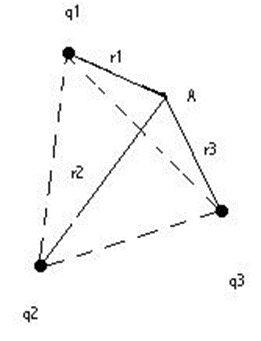Electric Potential , or Voltage
What is electric potential?
The electric potential, or voltage, is the difference in potential energy per unit charge between two locations in an electric field. When we talked about electric field, we chose a location and then asked what the electric force would do to an imaginary positively charged particle if we put one there. To find the electrical potential at a chosen spot, we ask how much the electrical potential energy of an imaginary positively charged particle would change if we moved it there. Just like when we talked about electric field, we don’t actually have to place a positively charged particle at our chosen spot to know how much electrical potential energy it would have.
We know that the amount of charge we are pushing or pulling (and whether it is positive or negative) makes a difference to the electrical potential energy if we move the particle to a chosen spot. That’s why physicists use a single positive charge as our imaginary charge to test out the electrical potential at any given point. That way we only have to worry about the amount of charge on the plate, or whatever charged object we’re studying.
Let’s say we have a negatively charged plate. We know that a positively charged particle will be pulled towards it. That means we know that if we choose a spot near the plate to place our imaginary positively charged particle, it would have a little bit of electrical potential energy, and if we choose a spot further away, our imaginary positively charged particle would have more electrical potential energy. So we can say that near the negative plate the electrical potential is low, and further from the negative plate the electrical potential is high.

What if our plate was positively charged? A positively charged particle would be pushed away from the plate. This is the exact opposite of the last case. Near the plate the electrical potential is high and far from the plate the electrical potential is low.
Figure of postive plate showing higher electrical potential of closer positive molecules
If we have two plates, as before, where one is positive and one negative with a space between them, the electrical potentials of the positive and negative plates combine, so we know that near the negative plate and far from the positive plate, the electrical potential is very low, but far from the negative plate and near the positive plate that electrical potential is very high.

Let r1 , r2, r3 be the distances of the charges to a field point A, and r12, r13, r23 represent the distance between the charges. The electric potential at point A is:

https://www.khanacademy.org/test-prep/mcat/physical-processes/electrostatics-1/a/electric-potential
Example 1: Let us say we have two charges of magnitude 1C and 2C placed at a distance 2 metre from each other. Calculate the electric potential between these two charges. (Take: k = 1)
Solution:
Given that, the magnitude of charges are q1 = 1C and q2 = 2C.
The distance between these two charges is r = 2m.
The electric potential between these two charges is given by, Ur = -[kqqo]/r
Substituting the given values in the above equation we get,
Ur = -1 J.